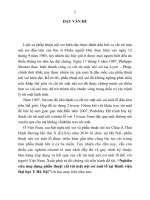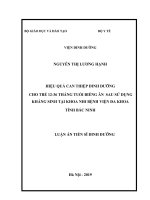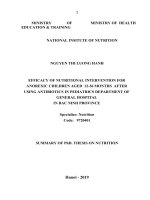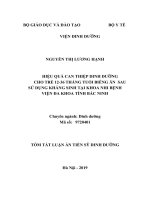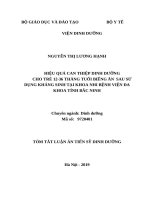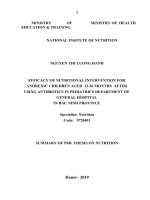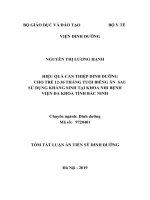Hiệu quả can thiệp dinh dưỡng cho bệnh nhân ung thư điều trị hoá chất tại bệnh viện đại học y hà nội tt tieng anh
Bạn đang xem bản rút gọn của tài liệu. Xem và tải ngay bản đầy đủ của tài liệu tại đây (457.38 KB, 28 trang )
1
1
BACKGROUND
Cancer incidence has been increased recently in the world as well as
in Vietnam and becoming the first leading cause of death. While
everyone diagnosed with cancer reacts differently, the diagnosis is often
associated with a lot of side-effects and other complications. These
complications affect directly to digestive symptom of cancer patients
such as: nausea, vomiting, indigestion, constipation and diarrhea, lead
to loss appetite, decrease absorption due to lose weight, malnutrition
and cachexia in the period of receiving cancer treatment therapies.
Additionally, cancer which related to digestive system is also cause of
loss absorption. Researches have shown that effects of nutritional
interventions contributed to improve energy intake, nutritional status
and quality of life in cancer patients. Cancer patient should be
diagnosed immediately signs of malnutrition and having timely
nutritional interventions in order to improve effects of cancer treatment
therapies. For these reasons, we carried out research: ''effects of
nutritional interventions in cancer patients who receiving
chemotherapy in Hanoi Medical University hospital'' this research
aimed to determine goals:
1. Describing nutritional status in cancer patients who receiving
chemotherapy in department of Oncology and Palliative care - Hanoi
Medical University hospital in 2016
2. Assessing effects of nutritional intervention in patients who
having stomach and colon cancer, receiving chemotherapy in
department of oncology and palliative care - Hanoi Medical University
hospital.
1. The importance of research
There were a lot of researches about nutritional intervention for
cancer patients. However, those researches mostly focused on cancer
patients who treated by radiation therapy treatments, especially with
head and neck cancer patients. In Vietnam, we haven’t had any
nutritional intervention research in gastrointestinal cancer patients
receiving chemotherapy so far. Rate of malnutrition in gastrointestinal
2
2
cancer patients was highly, nutritional practice for patients did not
satisfy recommendation. Additionally, nutritional recommendations for
cancer patients in Vietnam were not united and specific. We also had no
specific dietary for cancer patients receiving chemotherapy.
Correspondingly, nutritional advice and recommendations about high
energy and high protein dietary could be effective methods in order to
improve malnutrition status in gastrointestinal cancer patients. For these
reasons, the research was carried out in stomach and colon-rectum
cancer patients who receiving chemotherapy in Hanoi Medical
University hospital with expectation that it can improve nutritional
status for patients and provide effective recommendation about
nutritional intervention for cancer patients who receiving chemotherapy.
2. The new contributions of the research
The research has shown precise number about prevalence of
malnutrition in cancer patients receiving chemotherapy. The rate of
malnutrition in gastrointestinal cancer patients was higher than group of
patients non-related to digestive cancer. Research has built and applied
nutritional intervention projects for patients with stomach and colon
cancer who receiving chemotherapy based on recommendations of
ESPEN about energy intake, protein intake and necessary nutrients for
cancer patients. Research also has built some specific dietaries for
cancer patient. Especially, high energy soup productions by oral for
cancer patients in the period of receiving chemotherapy when patients
had signs of loss appetite because of chemotherapy’s side- effect.
Research also has given evidences that if patients provide enough total
energy intake and protein intake, they will have better nutritional status.
In addition, the research also has given evidence that nutritional
intervention contributed to improve quality of life of cancer patients.
3. Dissertation layout
Dissertation has 136 pages, including: summary (2 pages),
conclusion (2 pages), recommendation (1 page). In addition,
dissertation has 4 parts, including: Part 1: Summary about research (32
pages), part 2: participant and method of research (16 pages), Part 3:
3
3
results of research (25 pages), Part 4: Discussion (29 pages).
Dissertation also includes 21 charts, 9 photos, 127 reference documents
(English: 114, Vietnamese: 13)
4
4
CHAPTER 1. OVERVIEW
1.1.
Nutritional status of gastrointestinal cancer patients
There are many tools and methods to assess nutritional status of
cancer patients. According to data from researches, rate of malnutrition
in cancer patients based on BMI is about 21%-60%, depending on sex,
cancer types and stage of cancer. Rate of malnutrition and risk of
malnutrition in cancer patients based on assessment of PG-SGA was
extreme highly (41-71.1%), especially with gastrointestinal cancer
patients, this proportion is lower in group of cancer patients non-related
to digestive. Loss weight is the most popular symptom in cancer
patients, highly in lung, esophagus, stomach, colon-rectum, liver and
pancreas cancer, lowest in breast cancer and leukemia. Research of
Prashanth Peddi and colleagues in 2010 showed that 86% patients had
loss weight >5% and 77.5% patients who joined in research had signs of
cachexia.
1.2.Feeding
situation in cancer patients who receiving
chemotherapy
In fact, results of researches showed that total energy intake in cancer
patient was lower than recommendation. The research in Poland showed
that 78% patients had protein deficiency, research of Bauer in Australia
showed that, dietary of cancer patient only satisfied 60% total protein
intake. Rate of cancer patient did not reach recommendation was
significant highly, epecially vitamin C deficiency (85%), vitamin B1
(63%), vitamin A (55%) and vitamin (54%); deficiency of calci, kali,
magie appropriated 99%, 99% and 89%.
In Vietnam, the research was carried out in gastrointestinal cancer
patients who receiving chemotherapy in Hanoi Medical University
hospital 2017 showed that, only 36.4% patients reached
recommendation about total energy intake, 43.9% satisfied total protein
5
5
intake, rate of patients non-satisfied recommendation about vitamin
intake was significant highly including groups of vitamin A, B1, B2, PP
with proportions: 92.4%; 48.5%; 74.2%; 78.8%; rate of cancer patients
iron deficiency was 77.3%, proportion Calci deficiency was 57.6%. The
research in Bach Mai hospital showed that only 17.5% patients satisfied
recommendation about energy intake.
1.3.Goals of intervention research for cancer patients
According to recommendation of the European Society of Clinical
Nutrition and Metabolism (ESPEN), cancer patient should be provided
enough total energy intake is 25-30 kcal/kg/day. Recommendation of
National Institute of Nutrition for adult is 30-35 kcal/kg/day. Protein
intake maximum is 2 g/kg/ngày and minumun is 1g/kg/day. In cancer
patient had insulin resistance symptom, ESPEN recommended that they
should increase total energy intake from lipid rather than from
carbohydrate because it helps decreasing sugar blood of patients.
About vitamin and mineral, ESPEN recommended that cancer patients
shoud be supplied vitamin and mineral as recommendation for healthy
adult and no recommended using highly supplement dose without
specific deficiencies.
1.4. The effect of nutritonal intervention in cancer patients
1.4.1. The effect of intervention to nutritional status of cancer
patients
Intervention by supplying necessary nutrients or nutritional
counseling helped improving some output index of cancer patients. A
systematic review and meta-analysis from 45 researches showed that,
average weight increased about 3.75 kg in group which received
nutritional advice in compared to non-received nutritional advice group
after 12 months. Improvement of average weight was about 2.20 kg had
6
6
significant statistic in intervention group with nutritional advice.
Research of Bauer JD about nutritional advice and nutritional
supplement by oral within 8 weeks showed that had significant
improvement in intervention group was 2.3 kg, (2.7 – 4.5 kg), muscle
mass gained 4.4 kg, (-4.4 đến 4.7kg), however had no significant
statistic.
1.4.2. The effect of nutritonal intervention research to quality of
life in cancer patients
Nutritional intervention research helps improving nutritional status as
well as quality of life of cancer patients. The research of Ravasco
among 75 head and neck cancer patients, after radiation therapy,
group which received nutritional advice had higher quality of life
score rather than other and had significant statistic with p<0.003, in
proportion to improvements of nutritonal status and total energy
intake, whereas total quality of life score was not improvement in
non-intervention group. Conclusion, nutritional intervention had
positive effects to nutritional status and quality of life of cancer
patients.
PART 2. THE METHODOLOGY
2.1.Time and location of research
Research was carried out in Department of Oncology and Palliative care
–
Hanoi Medical University hospital from 2016 – 2019.
2.2.Study subjects
2.1.1. Objective 1. Assessing nutritional status
- Patients were 18 years old and over who were diagnosed cancer by
histopathology and receiving chemotherapy.
7
7
- Patients were explanted clearly about research and voluntary took part
in research.
2.1.2.
-
Objective 2. Choosing patients for intervention research
Patients were 18 years old and over who were diagnosed stomach or
colon cancer, receiving chemotherapy for the first time.
- Intake by oral, without other chronic diseases.
- Without mental illness, voluntary joined in research.
2.3. Designed research
Objective 1. Cross-sectional research
Objective 2. Clinical intervention trial. Assessment at baseline and after
internvetion, comparison between two group at baseline and after
intervention.
1
Sample size and selected the subjects
Sample size for cross-sectional research:
Sample formula:
n = Z 2 (1−α / 2 ) .
p.(1 − p )
(ε . p ) 2
p = 0,59, rate of cancer patient had risk of malnutrition based on PG-
ε
SGA;
: = 0.1; α = 0.05; Z(1-α/2) = 1.96. Sample n = 267,
estimate 5% patients drop out, n= 280 patients
Sample for intervention research: compared to 2 average value
8
8
We expected that after intervention, average weight in intervention
group increased 1.3 kg, d = 1.3 kg, σ = 3.6 kg, β = 0.1 and α = 0.05, r =
1 was proportion between two groups. Sample n1 = 45. estimate 20%
patients drop out, final sample was 60 patients for each group of research.
Selected the subjects
Objectives 1. All patients who met the selection criteria and were
admitted during the study period.
Objective 2. Stomach and colon cancer patients receiving chemotherapy at
the first time who met the selection criteria.
Pairing the patients with age: < 40 years old, 40-65 years old and > 65
years old; sex: male and female; cancer types: stomach cancer, colon
cancer; stage of cancer: stage 1 - 2 ; stage 3 - 4.
9
9
10
10
Figure 2.1. The step of Nutrition intervention
2
Content and nutritonal intervention plan
Control group
The patients had enough selection criteria with free dietary were
collected the information:
+ The patient hospitalisation, assessed nutritional status by
athropometric indexes, PG-SGA tool, quality of life and biochemistry
tests within the first 24 hours (T0) Classifed and diagnosed nutritional
status.
+ Patient with free dietary for 2 months.
+ Assessing nutritional status based on athropometric indexes, PGSGA tool, quality of life and biochemistry tests within the first 24 hours
hospitalisation atfter 2 months receiving chemotherapy (T1).
Intervention group
Patient was taken care of nutrition according the nutrition intervention
plan:
Step 1. Patients incharged the hospital, were assessed nutritional
status by athropometric indexes, PG-SGA tool, quality of life and
biochemistry test indexes within the first 24 hours (T0) Classifed and
diagnosed nutritional status.
Step 2. Planed and conducted the nutrition intervetion for cancer
patients:
+ Provided nutrition counseling
+ Indicated the specific dietary for each patient case based on
recommendation of ESPEN.
Energy intake: 30 kcal/kg /day
Protein intake: 1.2 – 1.6 g/kg/day
Step 3. Provided high energy dietary for each patient of intervention
group in the period of hospitalisation. Menu included 2 snacks (using
11
11
Leanmax hope formula). Especially, high energy soup production was
processed from avaiable food. All menus and soup were tasted and got
good confirm from the patients.
-
Patients before discharging from hospital: Dietician guided cancer
patients preparing high energy dietary from availble food, including
Leanmax Hope 400 ml/day, 2 times/day within 2 months.
Step 4. Following and assessment
-
Following daily dietary of cancer patient hospitalization in the period of
intervention by researchers.
-
Re-asessment risk of malnutrition.
3
Materials and assessment standard
Information was assembled by questions include age, sex, educationl,
information related to diseases situation.
+ Measured anthropometric indicators: height, weight, BMI, Mid
Upper Arm Circumference, Triceps Skinfold Thickness, body fat mass,
muscle mass.
+ Classified risk of nutrition based on PG-SGA: the Global
Assessment (A = well nourished, B = mild malnourished or moderately
malnutrition, C = severely malnourished)
+ Test indexes:
❖ Albumin: albumin < 35 g/l is malnutrition
❖ Prealbumin: <15 mg/dL is malnutrition
Patients were phoned one time per 2 weeks to follow weight as well as
gave nutritional advice for patients if nesessary.
Step 5. Adjust intervention plan if nesessary.
Step 6. Assessing nutritional status by anthropometric indicator, PGSGA tool, quality of life, test index within first 24 hours after 2 months
of intervention.
12
12
❖ Hemoglobin: diagnosed anamic when hemoglobin < 130g/l with
male and < 120 g/l with female.
+ Asessing quality of life: using EORTC QLQ-C30:
- Raw score (RS) = (I1 + I2 + …+In)/n
- Standard scores :
+ Function score: Score = 1 – [(RS – 1)/3] x 100
+ Symptom, financy score: Score = [(RS – 1)/3] x 100
+ Global health score: Score = [(RS – 1)/6] x 100
Measure quality of life
-
Satisfied quality of life:
Δ = after intervention score – Baseline score
+ Functions and total heath: bettter Δ ≥ 10, stable: -10 < Δ < 10,
worse: Δ ≤ -10
+ Symptoms: better: Δ ≤ -10, stable: -10 < Δ < 10, worse : Δ ≥ 10.
4
Data analysis
Data was analysed by Epidata. All results were analysed based on
Stata 16.0 software. Test χ2, Fisher’s exact test, McNemar’s Chi-square
test, Skewness/Kurtosis tests, T-test, T – test in paired and Wilcoxon
sign-rank test were used to warrant accuracy of research.
5
Research ethical
Research was accepted by Ethical Committee of Hanoi Medical
University, no.187/HĐĐĐĐHYHN, date 20/02/2016. The patients were
voluntary to be asked and involved to this study, and were explained
clearly about the goals
and the approach of this study and signed in the consents.
13
13
PART 3
RESULTS OF RESEARCH
3.1.Nutritional status of cancer patients who receiving
chemotherapy in 2016
3.1.1. General characteris of subjects
Research was carried out among 280 cancer patients with 51.1% female
and 48.9% male; average age is 56.2 ± 12.0. Rate of gastrointestinal
cancer was 74.3% and higher in male than female, (84.7% compared to
64.3%). Average weight and height were 52.5 ± 9.2 kg and 159.6 ± 7.9
cm.
3.1.2. Nutritional status of subjects
The prevalence of malnutrition based on BMI was 21.8%. Therein, rate
of malnutrition in gastrointestinal cancer patients was higher than rate
of malnutrition in cancer non-related digestive (24.1% compared to
15.3%). We found no signification statistic with p = 0.051.
Figure 3.1. Nutritional status of cancer patients based on PG-SGA
Figure 3.1 showed that 52.5% patients had risk of moderately
malnourished or severely malnourished based on PG-SGA. Therein,
group of gastrointestinal cancer patients had higher risk of moderately
malnourished or severely malnourished than group which non-related to
digestive cancer (58.2% compared to 36.1%). This difference had
significant statistic with p = 0.004.
Rate of patients had loss weight within 6 months was 77.5%, therein
rate of loss weight >10% appropriated 31.8%. Rate of loss weight
within 1 month before was 41.1% and loss weight > 5% within 1 month
was 13.9%.
According to Albumin classification, rate of malnutrition in patients
14
14
was 23.8%. Rate of malnutrition in gastrointestinal cancer patients
based on albumin was 26.3%, higher than group which non-related to
didestive cancer (15.1%).
3.2. Effects of nutritional intervention in gastrointestinal cancer
patients who receiving chemotherapy
Research was carried out among 60 patients of intervention group and
60 patients of control group. After 2 months, 10 patients in control
group drop out and 7 patients in intervention group drop out. Research
analysed 53 patients of intervention group, average age was 54.9 ± 10.6;
50 patients of control group, average age was 58.2 ± 9.97. The
difference was no significant statistic between 2 groups when we paired
patients based on age, sex, diagnosis and stage of cancer.
3.2.1. Effects of intervention to nutritional status of gastrointestinal
cancer who receiving chemotherapy
Table 3.1. Changes of body index at baseline and after intervention
Intervention group
Control group
Tim
Index
(1)
(2)
p1-2
e
(n=53) TB ± SD
(n=50) TB ± SD
T0
50.2 ± 7.4
50.5 ± 7.6
T1
51.6 ± 7.8
50.9 ±7.1
Weight
T10.03
1.4 ± 2.6
0.4 ± 2.3
(kg)
T0
p
0.0002*
0.19 *
T0
36.5 ± 5.8
37.0 ±5.7
T1
37.7 ±6.6
37.6 ±5.6
Muscle
T10.1
1.2 ± 4.1
0.55 ± 2.77
mass (kg)
T0
p
0.02 *
0.16*
MUAC
T0
25.3 ± 2.5
25.2 ±3.1
0.00
T1
25.6 ±2.9
24.6 ±3.1
15
15
T10.3 ± 1.8
-0.6 ± 3.0
T0
(cm)
6
p
0.29*
0.16*
*: Paired – Samples T test; **: Wilcoxon signed-rank test
Comment: Gained weight and muscle mass had significant statistic in
intervention group, gained MUAC also had significant statistic in
intervention group compared to control group with p < 0.05.
Table 3.2. Changes of body index of subjects at baseline and after
intervention based on cancer types
Intervention group
Control group
In Ti
p1 p2n = 53; TB ± SD
n = 50; TB ± SD
de m
Stomach
Stomach
Colon
-3
4
Colon (2)
x
e
(1)
(3)
(4)
T
50.99±6.
50.1
49.5±8.5
51.0 ±7.8
0
1
±7.6
T
wei
49.9±8.6
53.5±6.4
50.8 ±6.4 51.1±7.6
0.
1
ght
0.
T
00
(kg
4
17
0.4 ± 2.8
2.5 ± 1.8
-0.2 ± 2.3 0.9 ± 2.2
)
T
0
p
0.46*
0.000*
0.66*
0.02*
Mu T
0. 0.
36.3±5.8
36.7±5.9
38.2±6.0
36.1±5.4
scl
0
2 98
T
e
9
37.9±7.1
37.4±6.2
38.5 ±5.7 36.8±5.5
1
ma
T
1.6 ± 4.5
0.7 ± 3.5 0.34 ± 2.4
0.73 ±
ss
3.05
(kg 1T
)
0
16
16
p
0.04*
0.34*
0.52*
0.21*
T
24.99±2.8 25.7 ±2.1
25.0±2.5
25.3±3.6
0
M
T
24.8±3.2
26.5±2.1
24.3±2.5
24.8±3.5
UA 1
0. 0.
T
C
2 00
10.8
±
-0.54
±
(c
3 2
-0.2 ± 2.2
-0.7 ± 2.4
T
0.89
3.5
m)
0
p
0.62*
0.0001*
0.19*
0.42*
*: Paired – Samples T test; **: Wilcoxon signed-rank test
Comment: with colon cancer patients, after 2 months, average weight
gained 2.5 ± 1.8 kg in intervention group, whereas, control group
gained 0.9 ± 2.2 kg; muscle mass gained significantly in stomach cancer
patients after intervention, 1.6 ± 4.5kg compared to 0.34 ± 2.4 kg in control
group; MUAC in colon cancer patients of intervention group gained 0.8 ±
0.89 cm, had significant statistic with p = 0.0001, whereas control group
decreased -0.54 ± 3.5 cm with p = 0.42.
Table 3.3. Changes of nutritional status based on biochemistry
index of subjects from baseline to after intervention
Control
Tim
Intervention group, n
Index
group
e
(%)
n (%)
T0
13
(27.1)
15
(33.4)
Albumin < 35
T1
11 (31.5)
23 (54.8)
(g/l)
p
0.25 e
0.02 e
T0
33 (68.8)
23 (51.1)
Protein <65 (g/l)
T1
28 (80.0)
31 (72.1)
p
0.17 e
0.04 e
e
f
:McNemar’s Chi-squared test; :Marginal homogeneity (StuartMaxwell) test
17
17
Comment: Rate of albumin deficiency in control group gained from
33.4% to 54.8%, had significant statistic with p = 0.02, higher than
intervention group. Rate of protein deficiency in intervention group
gained from 68.8% to 80.0%, no significant statistic with p = 0.17; this
prevalence gained from 51.1% to 72.1% in control group and had
significant statistic with p = 0.04.
3.2.2. Effects of intervention to quality of life of gastrointestinal
cancer patients who receiving chemotherapy
Table 3.4. Improvement of quality of life score about functional
body at baseline and after 2 months intervention
Control group
Intervention group
Functional
Time
n = 50; TB ±
n = 53; TB ± SD
SD
T0
69.8 ± 16.0
81.4 ± 20.6
Physical
T1
87.5 ± 9.4
84.2 ± 18.3
Activity
Global
health
p
T0
T1
p
T0
T1
0.000**
57.2 ± 23.7
73.6 ± 19.2
0.000**
51.1 ± 15.0
71.9 ± 13.7
0.27**
75 ± 25.7
77 ± 25.6
0.52**
56.3 ± 16.3
60.2 ± 18.3
p
0.000*
0.26*
*: Paired – Samples T test; **: Wilcoxon signed-rank test
Comment: in intervention group, physical score gained from 69.8 ± 16.0
to 87.5 ± 9.4; activity score gained from 57.2 ± 23.7 to 73.6 ± 19.2;
global health score gained from 51.1 ± 15.0 to 71.9 ± 13.7 had
significant with p = 0.0001;
18
18
Table 3.5. Improvement quality of life based on symptoms of
patients at baseline and after intervention
Intervention group
Control group
Tim
n = 50;
Index
n = 53; TB ±
e
p
TB ±
P
SD
SD
20.4 ±
T0
25.8 ± 21.2
0.0002*
21.2
Fatigue
0.99**
20.2 ±
*
T1
15.1 ± 18.9
20.2
4.0 ±
T0
4.1 ± 14.6
Nausea,
9.9
0.04**
0.01**
10.3 ±
vomiting
T1
7.2 ± 12.5
16.1
17.0 ±
T0
19.5 ± 16.3
18.98
Pain
0.000**
0.02**
11.1 ±
T1
4.4 ± 10.4
17.6
5.3 ±
T0
8.8 ± 19.8
Dispnoe
0.0002*
16.98
0.007**
19.3
±
a
*
T1
16.98 ± 21.3
21.4
**: Wilcoxon signed-rank test
Comment: Quality of life through symptoms of patients such as fatigue,
nausea, vomitting, dyspnoea were improved after 2 months in both
groups (intervention group and control group). In intervention group,
fatigue symptom was improved and had significant statistic with
p=0.002, whereas this symptom in control group was not improved.
19
19
20
20
PART 4
DISCUSSION
4.1. Nutritional status of cancer patients receiving chemotherapy in
Oncology and Palliative care department – Hanoi Medical
University hospital in 2016
According to BMI classification, research has shown that rate of
malnutrition was 21.8%. This proportion was lower compared to
research of Nguyen Thi Lan Huong (26%), Pham Thi Tuyet Chinh
(23,9%) và Pham Thi Thanh Hoa in National Cancer hospital in 2018
was 35.2%; higher than research of Pham Thanh Thuy was 6.8%.
Similar to research of Wu GH (21.3%) and research of Wie G.A
(22.4%). Summarization from all researches has shown that rate of
malnutrition were different and depended on cancer types and stage of
cancer. Rate of malnutrition in gastrointestinal cancer patients in our
research was 24.1% and higher than cancer which non-related to
digestive with 15.3%. Gastrointestinal cancer affected directly to
digestive function and nutrients absorption ability of cancer patients, in
combine with other side-effects of chemotherapy treatment, digestive
and absorption ability of cancer patients was decreased.
Researches have also shown that risk of malnutrition based on
assessment of PG-SGA was serious (41 – 71.1%), especially with
gastrointestinal cancer patients with proportion about 53.4 - 86%. This
proportion was lower in groups of cancer which non-related to
digestive. Result of this research was quite similar with results of other
researches (about 52.5%). Therein, group of gastrointestinal cancer had
higher risk of moderately malnutrition and severely malnutrition (about
58.2%), higher than group of cancer which non-related to digestive was
36.1%. Similarly results with other researches in gastriointestinal cancer
patients at National Cancer hospital was 58.5%, non- significant lower
21
21
so compared to research of Roop C and colleagues in 2010 with 60%
patients had risk of moderately malnutrition and severely malnutrition.
The difference about rate of malnutrition based on PG-SGA could
explain that patients at the end stage of cancer had higher risk of
malnutrition than patients in early stage cancer. Research of Wie in
2010 showed that cancer patients in III-stage and IV-stage had higher
risk of malnutrition than patients in I-stage and II-stage. Conclusion,
rate of malnutrition based on PG-SGA tool was different depending on
cancer type and stages. Concurrently, using PG-SGA tool to assess
nutritional status was more effectively rather than using BMI.
Loss weight in cancer patients
Loss weight within past 6 months was popular symptom in cancer
patients based on results of researches. Our research found out 77.5%
patients had loss weight within past 6 months, therein, rate of loss
weight > 10% appropriated 31.8%. Rate of loss weight within past 1
month was 41.1%, therein rate of loss weight > 5% with in 1 month was
13.9%. This result was quite similar to research which was carried out
in cancer patients receiving chemotherapy treatment at Hanoi Medical
University hospital (2015) with rate of loss weight within past 6 months
was 68.7%, whereas rate of loss weight > 10% within past 6 months
was 27.2%.
Rate of loss weight was different depending on tumor site and stage
of cancer. This was higher in gastrointestinal cancer group as well as
patients at the end stage. The research of Sandra Capra was carried out
in patients with early stage also showed that, rate of loss weight and
malnutrition in breast cancer patients was 9%, whereas this proportion
of esophagus cancer patients was 80%. Loss weight in lungs,
esophagus, stomach, colon-rectum, liver and pancreas patients were the
highest, breast cancer patients and leukemia patients had the lowest
22
22
proportion.
Nutritional status based on Albumin
Result of research has shown that rate of malnutrition based on
albumin classification was 23.8%, this proportion was higher than
classification of BMI (21.8%) and lower than classification of PG-SGA
tool (52.5%). Research of Pham Thi Thu Huong with 34.1% patients
had albumin < 35g/l higher than result of our research, but also quite
similar to research of Nguyen Dinh Phu in cancer patients at 108
Military Central hospital in 2018 was 22.4% and research was carried
out in Malaysia of Kavitha Menon was 26%. Albumin serum related to
nutritional status, stage of cancer, cancer types,… therefore having
difference between proportion of albumin deficiency each research.
4.2. Effects of nutrtional intervention in gastrointestinal cancer
patients receiving chemotherapy at Hanoi Medical University
hospital
4.2.1. Effects of intervention to nutritional status of cancer patients
With intervention group, after 2 months, average weight of patients
gained 1.4 ± 2.6 kg, this change had significant statistic, p = 0.0002.
When we compared effect of intervention in both groups, average
weight of intervention group was higher than control group and had
significant statistic, p = 0.03. Whereas, gain weigh in colon cancer was
highest, 2.5 ± 1.8 kg in intervention group and 0.9 ± 2.2 kg in control
group, differences between 2 groups had significant statistic with p =
0.007. The effect of gaining weight in our research was lower than
research of Bauer JD in cancer patients recceiving chemotherapy and
nutritional counseling by supplyment dietary including protein and EPA
within 8 weeks, average weight gained 2.3 kg and had significant
statistic, lower than research of Badwin C (2011) with average weight
gained 3.75kg. This differences could be explained by period of
23
23
research as well as difference between sample each research. Generally,
effects of nutritional intervention were acknowledged in all researches.
With Mid Upper Arm Circumference, research has shown that
circumference of arms gained about 0.3 ± 1.8cm in intervention group
whereas control group decreased -0.6 ± 3.0cm. This change had no
significant statistic after 2 months in each group but had difference
between 2 groups, p = 0.006. When we analyzed each group,
circumference of arms gained 0.8 ± 0.89cm had significant statistic with
p = 0.0001 in intervention group with colon cancer patients. Whereas,
control group decreased -0.54 ± 3.5cm. This difference had significant
statistic between intervention group and control group in colon cancer
patients with p = 0.002. In short, our research helped improving
circumference of arms index in colon cancer patients after 2 months of
intervention. Our result was higher than result of Baldwin, C. and
colleagues, circumference of arms gained to 0.81mm but had no
significant statistic.
Decreasing muscle mass and increasing fat mass excessively (FM:
fat mass), called obesity with decreasing muscle mass (sarcopenia), it
could lead to negative effects to body functions of patients. According
to results of research, muscle mass gained averagely 1.2 ± 4.1kg in
intervention group and had significant statistic with p = 0.02 and 0.6 ±
2.8kg in control group and had no significant statistic. Especially,
muscle mass gained to 1.6 ± 4.5kg had significant statistic in stomach
cancer patients group with p = 0.04, whereas control group only gained
0.34 ± 2.4 kg and had no significant statistic. Research of Bauer JD and
colleagues has shown that had change of muscle mass about 4.4 kg (4.4 đến 4.7 kg), however this change had no significant statistic.
About nutritional status based on biochemistry index, rate of
albumin deficiency và total protein deficiency increased in both groups
24
24
after 2 months of intervention but highly increasing in control group
and had significant statistic. Intervention research of Jin T (2017) in
oropharyngeal cancer patients showed that improvement had no
significant about albumin in both groups before and after intervention.
Research of Shunji Okada and colleagues in Japan 2017 showed that,
patients had normal albumin index after 2 months treating by
chemotherapy and rate of side-effects of chemotherapy was lower about
15.9% compared to lower albumin index group (38.5%) had significant
statistic with p<0.01. Side-effect of chemotherapy affected to this group
with highly proportion compared to normal albumin group was 4.1 fold
and had significant statistic with p<0.001. Patients who were stopped
treatment and decreased treatment dose were higher than normal
albumin index group and significant statistic with p<0,01. In our
research, improvement albumin index in intervention group contributed
improving nutritional status for cancer patients, it had important role in
order to improve quality of life for cancer patients.
4.2.2. Effects of nutritional intervention to quality of life of
cancer patients
Acorrding to our research result, improvement quality of life score
about functional patients including physical and global heath status after
2 months in intervention group had significant with p < 0.0001.
Physical score also gained averagely 17.7 points in intervention group,
this score increased 2.8 points in control group had no significant
statistic. Physical activity score increased 16.4 points in intervention
group, control group increased 2.0 points had no significant statistic.
Similar, global health score increased 20.8 points, higher than control
group was 3.9 points.
Improvement of quality of life about symptoms of patients also
showed that effect of nutritional intervention in our research. Fatigue
25
25
score in intervention group decreased 10.7 points and had significant
statistic with p = 0.0002 whereas this score in control group was not
change. Nausea and vomiting symptoms did not decrease in both
groups, the similar other researches, side-effect symptoms of
chemotherapy increase after treament two months, related to third time
of receiving chemotherapy. In this period, patients were suffered mostly
side-effect of chemotherapy. Similarly, dyspnea symptom increased
both of groups. However, this score increased seriously in control group
compared to intervention group and had significant statistic. This
evidence also showed that positive effect of nutritional intervention in
our research. Pain symptom decreased 15.1 points in intervention group
with p < 0.0001, higher decreased in compared to control group, was
5.9 points and had significant statistic with p = 0.02.
Currently, there are many researches to assess effects of nutritional
intervention to quality of life in cancer patients, however it was carried
out mostly inpatient receiving radiation therapy. The research of
Ravasco and colleagues in 2005 aimed to improve quality of life and
other functional scores in colon-rectum cancer patients within 3 months
treating by radiation therapy showed that: both intervention groups had
positive effective to quality of life in cancer patients during the period
of treating by radiation therapy, better effects in group which was
received nutritional counseling. However, long-term effects was found
in cancer patient who received nutritional counseling and had
significant statistic. The research assessed effects of nutritional
intervention to output indexes of cancer patients receiving
chemotherapy of Bauer JD. Cancer patients received nutritional
counseling every week by nutritionists and advised supplying necessary
nutrients by oral using high energy and high protein productions with
acid eicosapentaenoic (EPA) during 8 weeks. According to result of
